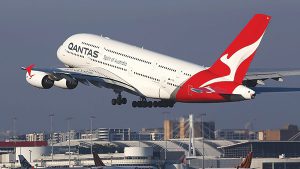Bloomberg
Qantas Airways Ltd has surged back to profitability on booming travel demand after most pandemic-era curbs were dismantled, helping shore up Alan Joyce’s position as chief executive officer and sending the shares to their biggest gain in two-and-a-half years.
First-half underlying profit before tax is seen at A$1.2 billion to A$1.3 billion ($816 million) — ending a streak of five consecutive half-yearly losses totaling A$7 billion, the Sydney-based carrier said in a trading update. Incidents of scrapped flights, late departures and lost bags are all declining, it said.
The airline’s rapid return to profitability and move towards pre-pandemic levels of punctuality takes some of the pressure off Joyce, who became the target of an explosion of public anger as Australia’s national airline struggled with the post-Covid resurgence in travel demand. The 56-year-old, who has led the carrier for more than 14 years, has repeatedly rejected calls to resign to take responsibility for this year’s slump in reliability.
“This is a remarkable turnaround because of how quickly it has happened,†Joyce said on a call. Asked whether he should bring forward his retirement, Joyce, who has previously agreed to stay on at least until the end of 2023, replied: “There’s no change to my plans.â€
“Qantas’ profit could hit a record in 2023, ahead of our expectations that it would reach that milestone only in fiscal 2024. Capacity ramp-up through this fiscal year, after accounting for the 20% cushion to reduce flight delays, also appears to be sooner than what the company projected in August.â€
The surge in travel demand immediately after Covid restrictions eased this year caught Qantas on the hop. After axing more than 8,000 workers to weather the pandemic, the airline found itself hamstrung by labour shortages, illness and a shrunken fleet.
On-time performance improved to 69% in September from 67% in August, while cancellations fall to 2.4% last month from 4% in August. To help maintain this improvement, the airline will spend A$200 million in the remainder of fiscal 2023 on rostering additional crew, training new staff and paying overtime. Workers will also be rewarded after a two-year wage freeze. The airline will bump up wage increases to 3% from 2% for around 20,000 staff at a cost of A$40 million a year.
“It’s clear that maintaining our pre-Covid service levels requires a lot more operational buffer than it used to,†Joyce said in the update. “That means having more crew and more aircraft on standby and adjusting our flying schedule to help make that possible, until we’re confident that extra support is no longer needed.â€
 The Gulf Time Newspaper One of the finest business newspapers in the UAE brought to you by our professional writers and editors.
The Gulf Time Newspaper One of the finest business newspapers in the UAE brought to you by our professional writers and editors.
